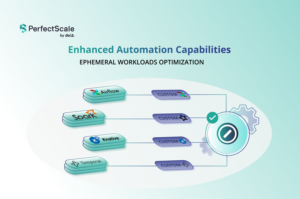Harnessing multiple clouds can help you advance your business goals
Multicloud is one of the most important trends shaping the evolving cloud market. The prospect of blending the best available cloud capabilities and prices spurs companies to leverage multiple clouds in pursuit of operational efficiency, security and scalability.
But pursuing the promise of multicloud brings its own challenges.
That’s why we’ve launched The Multicloud Handbook, a new guide to managing multiple clouds as you work toward your business objectives. We provide advice based on years of experience, enabling you to craft a strategic approach to multicloud informed by your organization’s specific circumstances and objectives.
Why multicloud appeals
Most companies using the cloud are sourcing cloud computing and storage services from more than one cloud service provider. With 89% of cloud customers now choosing multiple cloud hosting providers, multicloud adoption ranges from using several different software-as-a-service (SaaS) products to running multiple applications on platform-as-a-service (PaaS) or infrastructure-as-a-service (IaaS) from different cloud vendors. Multicloud environments may or may not be interoperable, and they can rely on third-party public clouds, on-premises private clouds or a hybrid.
Key reasons why companies choose the multicloud route include enhanced business resilience, greater flexibility, access to cutting-edge solutions and increased cost-efficiency.
Business resilience
Multicloud supports business continuity by allowing organizations to distribute systems and workloads across more than one cloud platform. If one service experiences latency issues or goes down, the capacity to migrate your workload to a different service creates an alternative. This gives companies peace of mind and protects against the damage to revenue, productivity, operational efficiency and reputation a major outage could cause.
Operational resilience is boosted by vendor-agnostic services for core infrastructure and data, which release the benefits of all clouds. Some cloud providers are starting to cater to the growing multicloud audience by decoupling orchestration from infrastructure and making it easier for enterprises seeking to leverage multiple cloud services. This growing flexibility will allow more organizations to deliver entirely cloud-native applications with minimal architectural dependence on a specific cloud provider.
Increased flexibility
Companies may turn to a multicloud strategy to avoid vendor lock-in and leverage best-of-breed solutions from a range of providers. Multicloud provides the freedom to choose cloud services from different providers based on price, performance, geographical location and security and compliance requirements.
The platform portability enabled by a multicloud architecture increases agility not just in areas like disaster recovery but also in performance optimization. Companies can pair a given workload with the most appropriate service and deploy it practically in real time on-premises or in a specific public cloud.
Enhanced performance
Multicloud can accelerate performance in several ways. Cloud-agnostic technology such as Google Anthos works across multiple clouds, streamlining the collection of data from all points so that customers can leverage it for valuable insights that drive the development of new products and services.
Companies can spread workloads across multiple clouds for optimal responsiveness, particularly when demand is high. Choosing clouds according to their geographic proximity to customers helps minimize the number of network hops between servers for minimal latency and other performance inhibitors. Access to best-of-breed technologies from any cloud vendor gives multicloud customers a range of cutting-edge resources to release innovations ahead of their rivals.
Cost savings
Businesses that adopt a multicloud approach can leverage their access to multiple clouds to maximize savings and avail of the compute discount plans on offer from cloud providers. A common management layer (also known as the single pane of glass) provides visibility into cloud spend, so that companies can reduce waste and create new efficiencies. A product like DoiT’s Flexsave means you can maximize your compute savings without committing to compute usage from a particular vendor.
Where multicloud gets complicated
Businesses may be adopting multicloud – but not necessarily in a deliberate or planned way. With different computing platforms supporting various workloads, businesses often end up supporting multiple public clouds and private cloud services with no clear strategy. However, adopting multicloud in an ad hoc manner makes it harder for multiple cloud environments to speak to each other efficiently while upholding data governance and cybersecurity standards in a cost-effective manner.
Apart from cloud creep, other multicloud challenges include technical complexity, visibility issues, governance and security and controlling costs.
Technical complexity
Deploying efficiently to more than one cloud is difficult. Open-source technologies such as Kubernetes make new implementations less disruptive and enable development teams to move workloads more smoothly – but few cloud providers’ tech stacks enable true interoperability among diverse clouds. Leveraging different clouds’ functionality and managing those clouds so they work as a unified whole takes advanced skills – which are in short supply.
Visibility
Without adequate visibility, different cloud instances, services, microservices and containerized componentry mingle into a sprawling network of data traffic serving a huge variety of applications. Transparency requires a single interface for observability, but many network visibility tools work only within proprietary cloud ecosystems. This makes them vulnerable to outages within that cloud and means they fail to give businesses the holistic view they need across clouds to ensure optimal performance and efficiency.
Governance, compliance and security
Multicloud may help you meet governance requirements for storing customer data in specific geographic locations (GDPR, for example), but these regulations also impose exacting standards around multicloud environments. If anything happens to customer data as it moves between platforms, responsibility ultimately rests with you – not the cloud vendor.
Implementing unified security measures across multicloud environments is tricky when cloud vendors use different measures and when companies implement security several times within the development process rather than integrating it from the start of the process.
Costs
When managed properly, multicloud can drive substantial cost savings. But, without proper visibility of where applications are hosted and whether they are running efficiently, cloud costs can be difficult to control. Complex cloud billing for individual clouds doesn’t help. As a multicloud customer, you could stop using a specific cloud vendor’s services if costs rise unexpectedly, but it’s not always easy.
How to negotiate multicloud complexity
Navigating multicloud is a challenge worth mastering. Companies with a purposeful multicloud strategy cut costs and enhance performance to gain a business edge. Such a strategy begins with an honest assessment of your existing company culture, DevOps practices and tech stack. Use this review to inform your multicloud management plan – a robust, multiyear roadmap for digital empowerment focused on the key pillars of people, processes and technology.
People
Demand for skilled staff is intensifying with the expansion of the cloud footprint. Sourcing the right expertise is now the biggest cloud challenge for companies, after security. Given the lack of available talent on the employment market, businesses will need to invest substantially in retraining, upskilling and reskilling existing employees. Training must be ongoing to keep teams’ skills up to date. Relying on an external partnership is a good way to leverage limited internal resources. An experienced cloud partner can deliver the kind of recommendations and support that save you time and money on your multicloud activities in the long term.
Processes
IT functions often operate in silos with little coordination or transparency among them. With different policies for everything from security to data management, they rely on manual enforcement, which leaves them vulnerable to error and inefficiency. This becomes even more problematic when teams are working with multiple clouds.
To manage the multicloud model, functional silos must be removed and processes should be streamlined. Adopting approaches such as DevOps, FinOps and DevSecOps will help companies to extract greater business value from their cloud use.
Technology
Companies can combine technologies to gain full visibility and control of all their cloud environments. Prioritizing automation and open source is key to managing across dispersed environments.
Automation
Technologies that avoid manual processes as much as possible will help cut time to market, increase productivity and morale among employees and reduce costly human errors. Companies need to aim for full automation of unit and integration tests, adding standardized configurations as part of deployment automation and providing self-service access to the operations developers need to deploy and operate their systems.
Open source
A key element of many successful multicloud strategies is open source. Open-source technologies such as Kubernetes give companies greater flexibility and independence from proprietary platforms, allowing developers to inspect and modify the source code as fits their requirements. This enables faster adaption and innovation and helps prevent vendor lock-in. By prioritizing open source technologies that can be applied consistently across all applications, businesses can move toward a unified multicloud management strategy.
Taking the next steps
As more cloud providers decouple orchestration tools from infrastructure, it may become easier for businesses to manage their workloads in multiple cloud environments. For many companies, leveraging multicloud for true business value will mean consulting an experienced cloud expert to guide them as they apply the benefits of the multicloud model to dominate their particular niche.



